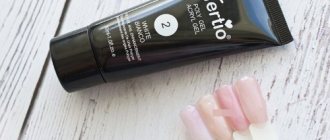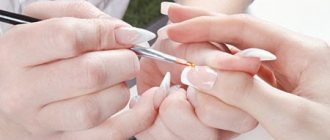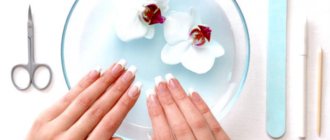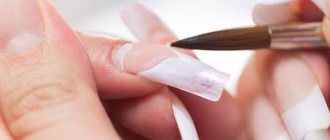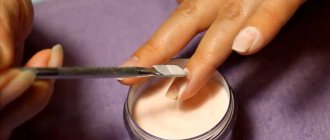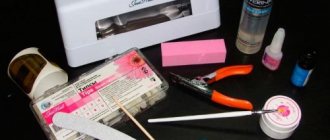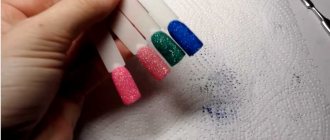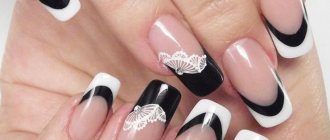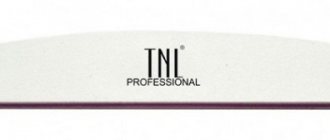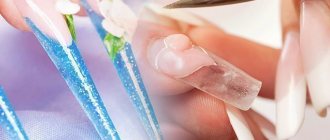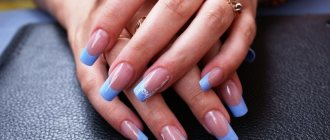Features of using upper forms for extensions.
Top forms have appeared in the nail industry for quite some time. They have been used since the advent of gel, but few masters can boast of such skills. The fact is that they were originally developed as a way to extend nails using acrylic or gel. But just a year ago, with the advent of polygel, top forms became popular again. In this article we will tell you how to extend nails using top forms.
Acrylic nail extensions: advantages of the material
Acrylic is very easy to use, it has many advantages:
- No pungent or unpleasant odor.
- No additional tools are needed for the job; acrygel can be applied with regular gel or acrylic brushes.
- There is no dust from the polygel, particles do not hover in the air throughout the procedure.
- Does not create streaks.
- Does not cause allergies.
- Saves time - you work faster with gel.
- Durability and long wear.
- The most natural looking nails.
- There is no burning sensation when drying your hands in the lamp.
Now, knowing the benefits of acrylic, you can take a closer look at acrylic nail extensions step by step.
Important: when applying polygel extensions from some manufacturers, you need to use a special liquid. But if it is not there, the problem can be easily solved with regular alcohol.
Tools and materials for polygel nail extensions
To make perfect extensions, craftsmen often use modern and innovative polygel. Almost all manufacturers call it differently. If you hear such product names as acrylic, acrygel, combigel, you can rest assured that we are talking about polygel.
To work, you will need a professional set of tools and consumables.
What you need for polygel nail extensions, list:
- Polygel.
- Base coat and topcoat.
- Manicure tools – brushes, napkins, scissors, etc.
- Antiseptic.
- Degreaser.
- Primer.
- Files of different sizes and purposes, buffs.
- Decorative elements for design.
- Led or UV lamp.
Acrylic nail extensions step by step
The procedure is quite simple, even beginners can quickly master this technique without much difficulty.
Once all the tools and consumables have been prepared, you can begin to work.
Step-by-step instructions for polygel nail extensions:
Sterilization of instruments.
- Preparing the nail plate. The length is adjusted and the cuticle is removed. For such a manicure, you can use any method: edged, unedged, hardware or combined.
- Then the nails are polished, degreased and moisture is thoroughly removed using a primer. It also provides better adhesion of the gel to the nail plate.
- A base layer is applied. It must be very thin. The base is used to securely fix the acrygel. Apply it with rubbing movements.
- After the base has dried under the lamp, you can carefully apply a layer of polygel using a special manicure spatula. Due to the ductility of the material, acrylic can easily stretch over the entire surface of the nail, right down to the side ridges and cuticle. Therefore, you need to apply the material to the middle of the nail plate.
- Be sure to dry thoroughly under a lamp.
- Apply finish and dry thoroughly again.
- Finally, remove the sticky layer and apply a buff to make the nails shine, as well as a nail file to carefully remove all imperfections.
- A design is created at the client's request.
If you want to master polygel nail extensions, the instructions are quite detailed and understandable not only for experienced nail artists, but also for beginners.
Gel nail extensions on forms: video instructions
No matter how detailed the instructions are, the best way to highlight the essence of the process will be a video on how to extend nails onto forms. Naturally, each master uses his own technology and his own secrets, we bring to your attention two video tutorials on how to extend nails onto forms with gel, which, in our opinion, shows in the most accessible form a process that is understandable even for a beginner. Lesson #1.
Lesson #2.
As you can see, each master uses his own skills and tricks in gel nail extensions on forms. Step-by-step technology is slightly different, but only in a few ways. The main basic “steps” - preparing the nail, setting the form, applying modeling gel - are unshakable. Perhaps in the future, as you gain experience and skill, you will find your ideal solution, more effective and convenient. In any case, try, learn and you will succeed.
Varieties
Today, two types of upper forms are known. Depending on the cost, they can be either with or without markings to facilitate the work process. The first option is especially convenient for beginners who are getting acquainted with nail extensions using such templates.
The markings on the forms may differ; in some places they are arched stripes, in others they are a grid.
The set has the same arch and length, as well as markings with the indicated dimensions. Based on the marking lines, it is easier to align the length and adjust the edge. There is no need to tediously adjust an identical shape, since it already exists.
The upper forms are classified as reusable types of extension templates. They differ from arched counterparts and liquid tips.
Step-by-step instruction
After all the preparatory procedures, you can proceed to the stages of artificial turf modeling. The extension must be done first on the four fingers of one hand, then on the other, and only then on the thumbs. This is necessary so that the coating does not run off during application. Beginners usually work on each finger separately.
Depending on the type of templates, the process may vary slightly.
For gel extensions using lower structures, the technique will look like this:
- Place the form under the free edge of the nail. If the product is hard, then this will be quite easy to do. However, when using disposable paper templates, adjust the window depending on the size of the arch under the nail. Make sure there are no gaps or creases. Having fixed the shape, make sure that it has a smooth bend without a springboard or, conversely, a steep slope. If the shapes are very soft, you can glue the two structures together.
- Apply a thin layer of gel to the base of the nail in the cuticle area, thickening it as you approach the transition zone from the natural nail to the form. The stress zone (in the transition area) needs to be compacted especially well. Next, cover the future end of the artificial nail with a thin layer again.
- Dry your nails under the lamp for 2-3 minutes.
- Remove the sticky layer from the hardened gel and carefully remove the mold.
- Sand the surface and adjust the free edge of the plate.
- Apply camo or any of the colored gels in two or three layers, curing each application under a lamp. Create a design if necessary. When finished, coat your nails with topcoat and keep it in a UF lamp for a longer time.
- Remove the sticky layer and lubricate your hands and cuticles with a moisturizing emulsion.
When using upper forms, the extension technology will be different:
- Select a template that matches the size of the natural plate.
- Apply a special gel or acrylic to the inside of the product in the area of the free edge and dry in a lamp for 20 seconds.
- Fill in the rest of the template to match the length of your natural nail. Press firmly onto the plate, starting from the cuticle area, and dry in a UV lamp for 30 seconds.
- Remove any gel protruding beyond the mold without changing the position of the product. Dry your nails again, this time for about three minutes.
- With a slight movement, remove the mold structure.
- File and apply a finishing layer or decorative gel.
Nail extensions on top forms / LadyWow
How to choose?
When buying top forms for nail extensions, you should pay attention to a number of nuances. For example, the inside of templates is very important. It should not have visible defects; a quality product will leave the desired gloss on new nails.
Typically, such frames are enough for 40-50 extensions. It is better to buy a frame with markings, especially for novice craftsmen.
When choosing the required option, you should take a closer look at the shape of the templates, which may differ. Sometimes it is more curved, sometimes the difference may be in the height of the arch. It is better to take the option in which the manicure hatchet can fit in the space between the form itself and the nail plate.
It is recommended to purchase sets with a large number of elements - this will allow you to select the required sizes as accurately as possible.
Depending on the type of sculpting product, when applying extensions to silicone top molds, you may need gel products, as well as base, top and acrylic. In addition to them, you need to prepare the templates themselves, primer material for coupling (primer), cuticle oil, glossy coating, dispersion layer remover, brushes, files, orange stick and dehydrator.
List of materials and tools
- ultraviolet lamp with built-in timer for drying the gel;
- clear camouflage gel;
- flat brush with artificial bristles;
- degreaser for nail plates;
- forms for base under the nail;
- gel for shine and fixation;
- nail files in a set, different in hardness;
- buff file for polishing;
- disinfectant;
- oil for degreasing cuticles;
- tip cutter to remove excess length;
- brush for polishing nail pads;
- sticky layer remover.
What's better?
It is impossible to say unequivocally which of the two materials is better, since each option has its own advantages. For example, acrylic dries faster, which affects the time of the entire work process. In addition, it is easier to lay it out in a thin layer, making it look more natural.
It should be noted that acrylic has an attractive price, it is economical to work with and is characterized by high strength.
When applying gel nail extensions, you can afford various fantasy solutions. For example, even a French coat can be made with colored materials of this type. However, if you don’t have a special lamp at home, you should try acrylic modeling.
The difference between the upper forms and the usual ones
The usual forms mean tips, liquid tips and disposable templates for extensions.
- The upper ones are reusable. After polymerization, the material separates effortlessly and leaves no marks on the workpiece, so it can be used until it loses its bending. Approximate service life – 2 years,
- The top forms do not polymerize along with the coating, but are removed immediately after the material has hardened,
- The technique of working with forms allows you to save material and create nails that are close in thickness to natural ones,
- The extension procedure is halved and ranges from 1 to 1.5 hours including decoration,
- The end result requires almost no modification. After polymerization, you only need to remove excess and polish the resulting nail,
- Unlike liquid tips, where the material is applied only to 2/3 of the natural nail, top forms involve laying gel over the entire nail plate,
- There is no need to add material after removal.
Technique for gel nail extensions on forms
First, let's figure out what forms for nail extensions are. As you know, there are two options for nail extensions:
- On forms
- On tips
Tips are ready-made plastic blanks for future nail tips. They are fixed with an adhesive base and modeled using gel.
Photo from the site: nailart-sho.ru
Forms for creating nails are a kind of substrate with a small window for the nail plate. During the work, a modeling gel is applied to the substrate and natural keratin, which after polymerization will represent an artificial free edge of the nail. For the convenience of forming this very free edge, the forms have a drawing in the form of graph paper, which allows you to calculate the approximate width and length of the nail being formed. The very basis - the form - is removed after the procedure is completed. Therefore, nails created on the basis of forms look thinner than nails formed on tips.
Photo from the site: onlinepeek.ru
There are two types of forms:
- Disposable, they are also called soft. They are made from paper or flexible plastic and are used only once. Due to the fact that they have a pliable structure, they can be easily adjusted to any contour of the natural nail. However, they can wrinkle during the extension process and require precise “fitting”.
Photo from the site: allfornails.ru
- Reusable molds are made of hard plastic or metal. Their price is much higher than that of disposable forms, but due to repeated use they will quickly recoup their cost. In addition, in the process of working with them, such troubles as deformation, the formation of gaps and the flow of gel through them are excluded. The main thing is to choose forms that perfectly match the shape of the natural nail bed, and then you will never have problems with the formation of an artificial nail.
Photo from website: nazya.com
It is believed that extensions on forms require more filigree work and experience from the master, while tips are easier to use. However, nails formed on forms look more natural, and this determines their popularity. Fortunately, the Internet is replete with all sorts of video tutorials on how to extend gel nails onto forms, which show the entire procedure with extreme accuracy. With a little practice and diligence, even this procedure can be done at home.
Common problems with hair extensions
- The natural nail plate is completely flat or its edge tends upward. In such cases, the stress zone is difficult to form and most often remains the weakest in the extended nail.
- What to do: Before printing the material, drop a little polygel in the center of the stress zone. The ball should be no more than 1.5 mm in height and no more than 1 mm in width. Dry the ball in the lamp and start printing.
This technique will help keep your shape at the desired level and prevent it from falling below the required level.
- A very arched nail. When looking at the end of the free edge of a natural nail, a strongly rounded arch is visible. In this case, it will not be possible to press the workpiece tightly, since the transverse arch of the workpiece will not be so rounded.
- What to do: before imprinting the form, add a little polygel to the natural nail in the cuticle area. This technique will help smooth out a steep arch.
- Nails grow downwards. If the nail plate tends downwards, the edge of the workpiece at the cuticle will constantly move away.
- What to do: Place a small layer of polygel near the cuticle, as well as drops in the center of the stress zone. Only after the layering has polymerized, start printing.
- Large gap between cuticle and mold. There is no need to install the workpiece tightly to the cuticle, but there should not be a large gap. The maximum indentation is 1 mm.
- What to do: File the plastic blank on the sides so that the edges do not interfere with moving it closer to the cuticle. You only need to cut down a little bit so that there are no gaps in the side sinuses.
- There is no free edge. To work with top forms, it is best that the natural nail has at least minimal regrowth. The distal edge will help avoid material leakage and also increase the strength of the structure.
- What to do: Before modeling, complete the free edge with polygel. You can do this on disposable paper blanks.
More detailed instructions for extensions
First stage
- After disinfecting the palms and fingers with an antiseptic, we treat the nail plates.
- Use a wooden stick to push back the cuticle. It is advisable to trim off the excess using special nippers or sharpened nail scissors.
- Carefully file the nails, leaving approximately 1-5 mm. Use an orange stick to remove dirt under your nails.
- The top glossy layer is removed with a buff and unevenness is removed. Use a brush or brush to shake off the dust.
- We degrease the nail plate using a special product. At home, you can use alcohol to soak a napkin.
- A primer is applied, it ensures adhesion of the material to the nail plate and protects against microbes.
Second phase
After the nails are processed, we select the upper forms of a suitable size, one by one applying them to the nail plate.
The blank should be slightly smaller than the nail plate. The free space will be filled with excess gel.
- The nail is covered with a thin base layer of gel. It should not be dried out.
- The inside of the workpiece is carefully filled with a denser layer of material in the area of the free edge, which should be dried after application (20 seconds). The gel is then applied to the area intended to adhere to the nail plate.
- The procedure can be simplified. A thin layer of gel covers the part of the plate that comes into contact with the nails. The free edge of the workpiece is compacted more tightly (0.5-1mm). At this stage of modeling, you can also determine the approximate desired length of the nail.
- The gel-filled blank is carefully pressed against the nail. There is no need to put pressure on the plate. Turning your palm over, you need to see how the gel lays down; its excess is removed with a pusher.
- Fingers with applied tips are placed under a UV lamp for about five minutes and wait for the material to polymerize. Manufacturers indicate on the packaging how long it takes for the material to harden.
- Once the gel has hardened, the top molds are carefully removed. We wipe the tip and put it back in the box. The nail is degreased. The free edge is processed with a file, which is given a neat appearance.
- To consolidate the result, this extension technology provides the possibility of applying a finishing coating. It is advisable to do this, but there is no particular need. This layer is polymerized for about two minutes.
- Degrease the nail plate. Lubricate the cuticle with special oil.
Extensions on top forms using gel
If you want to decorate your hands with the perfect manicure that will look natural and natural, and the result will be even more elegant and durable, you need top nail extensions with gel. The modern nail industry has a new product in its arsenal - LED gels. These building compounds allow you to speed up the extension process. Under a special LED lamp they freeze in half a minute.
French on top forms with gels
This kind of French is done very simply and quite quickly. If you are familiar with extension technology in general, you can carry out nail extensions with top forms of gel at home yourself, using a step-by-step scheme:
- Treat your hands with a special disinfectant solution and push back the cuticles.
- Use a nail file to trim the free edge.
- Treat the surface with a file for better adhesion, making it rougher. Degrease the surface and apply a product to improve adhesion.
- Select the size of the workpiece so that it is slightly larger than the natural plate.
- Fill the blank with white gel, creating a free edge, and draw a smile line.
- The workpiece is placed under the lamp for 20 seconds.
- Using pink gel, the body of the nail is modeled.
- A special design compound for coupling is applied to the workpiece.
- The form with the material is applied to the cuticle, the excess is moved to the free edge.
- The finger is placed under the lamp for 20 seconds, pressing the shape.
- Leave your finger under the lamp for 6 minutes until the composition dries completely.
- By lightly pressing on the ends, the workpiece is removed and the free edge is filed down.
When applying material to a workpiece, you can turn it over at any time and evaluate the result.
What base should I use for acrylic?
Which base to use - this issue must already be decided based on the brand of polygel that you are using, however, it should be noted that the material is well compatible with base coats of different brands.
Working with acrylic does not require applying a base; it adheres perfectly to the natural nail plate; preliminary application of a primer will be enough. Using a database is acceptable, but not a required step.
What else is needed for acrylic extensions?
There will be no additional costs for instruments (for example, brushes or preparations). Polygel can be applied with a gel or acrylic brush. For some manufacturing companies, together with the polygel, you will have to purchase a special liquid - a clinser, which will be as compatible as possible with the modeling material.
These nuances pale in comparison to the mountain of benefits that we will receive by choosing acrylic extensions.
How to choose acrylic? What do polygel manufacturers offer us?
The nail industry market is developing dynamically and constantly pleases with new products for both design and modeling. Therefore, the variety of polygels will be constantly updated with new types and brands. At the moment, there are two main directions in the range of polygels:
Acrylics, which in their texture are very similar to the acrylic mass, which was obtained by mixing powder and monomer.
There are even small particles of acrylic visible in them, the structure of the material is paste-like, very thick, the material is distributed by pressing movements. As a rule, these are polygels made in the USA or Germany, since acrylic technology is more popular in Europe and America, and craftsmen are more accustomed to working with acrylic textures. An example of this format is polygel TM GGA Professional.
Polygels, which in texture resemble a very thick gel soufflé or gel jelly.
They are also very thick, but the structure is more like a gel, there are no visible acrylic particles in them, the texture is more like a soufflé than a paste. Most of these materials even have surface self-leveling properties (that is, the material does not spread over the edges, but surface irregularities are smoothed out during modeling).
Such materials are produced mainly in China or Korea, since in these regions the gel extension technique predominates and the gel texture is more common in use.
Also, it was from China and Korea that the technology of polygel nail extensions on top forms came to us. An example of this type of acrygel is Canni polygel, which can be purchased in our online store.
We recommend the most flexible material with excellent performance qualities and a varied palette of shades.
The choice of a subtype of polygel and its brand is a matter of preference of the master: which texture is more familiar and comfortable to work with is up to you to decide. The most important thing is the end result and the pleasure of wearing it: durable and most natural nails, durability of the manicure before correction, safety and environmental friendliness of the material.
Polygel has these properties 100%, you just have to choose your “favorite”!
Tips for using acrygel
We recommend using the products as follows:
- Acrigel is applied only to the prepared nail. It is necessary to pre-treat the surface with a buff, degrease, cover with primer and base for gel polish.
- Acrigel does not level out on its own like a gel; it must be applied to the nail with a special brush.
- A ball of small diameter is placed on the nail, then using a flat brush it is given the required shape. The brush must be dipped in a degreaser, a means to remove the sticky layer.
- Acrylic gel can be used as on conventional standard forms
- and on the upper forms
The material is polymerized in an LED or UV lamp with a power of 36 W or more. This takes up to 2 minutes.
! An important point: in lamps up to 36 W, acrygel does not polymerize.
The final stage of applying the polygel is smoothing the surface using a file. We finish forming the nail with it.
Using acrylic
Extensions with upper forms can be carried out not only with gel, but also with acrylic used as a filler for blanks.
- The first stage is completely repeated.
- Second phase.
- The required size tips are selected.
- Two or three acrylic balls are placed in the blank. Then carefully distribute the material over the surface of the tips.
- The tip is pressed tightly to the nail, they look at how the material lays down and, if necessary, adjust it.
- Nails with blanks filled with material are polymerized in a UV lamp for about 2 minutes. After which the tip is carefully removed. The resulting coating does not need to be sanded.
- We repeat points 11-13.
Important! Acrylic is a much cheaper, durable and economical material. The advantage of the gel is that you can use different colors when modeling the nail plate.
What types of acrylic gels are there?
- In banks
- In tubes
The material in the cans is a little softer than in the tubes. Each manufacturer mixes acrylic and gel in different proportions, which is why the density and consistency may vary slightly.
How to remove acrylic
A 160-200 grit file or router is suitable for removing material. Soaking polygel is useless and harmful to nails.
How the top forms came to be
We all remember that happy, carefree time when, as small children, we played in the sandbox, filled various molds with wet sand, tipped them over and made Easter cakes. A simple game that is loved by all children.
Even in childhood, it was clear to each of us that sculpting a beautiful and even figure ourselves is much more difficult than simply pouring sand into a ready-made mold and turning it over.
Now imagine how great it would be to transfer this method (with certain changes, of course) to the nail service, using something similar for nail extensions!
Imagine how much easier the process of nail extensions would be if we had a mold prepared in advance for each nail, into which all we had to do was put the construction material (acrylic or gel) and turn it over, as if gluing the material onto a natural nail!
And then, after waiting for the material to dry, remove the mold and get a finished nail, shiny and smooth!
In 2007, the Formula Profi company introduced a new, unique nail extension technology that used the above-mentioned principle. The new technology is called upper forms. It is based on special plastic forms into which the material is laid out.
In order to evaluate the pros and cons of the upper forms technology, we will try to understand how it differs from earlier, preceding technologies.
Advantages and disadvantages of upper forms
Advantages
- The most unpleasant and dangerous extension procedure, filing, is eliminated
- The extension procedure time is reduced to 30-40 minutes
- Saving material reduces the cost of extensions
- The design possibilities are unlimited and execution is very simple.
- Possibility to demonstrate the design to the client before extension
- Perfect gloss
- Same shape for all nails
- Correctly formed stress zone
- Same arch on all nails
Of course, any technology has its pros and cons. Compared to classical technologies, top mold technology is not as versatile.
In particular, there are restrictions on the length and width of the nail (it cannot be greater than the length and width of the upper form).
So, the disadvantages of the upper forms:
- Limitation on the length and width of the nail
- The need for training and purchasing a rotating lamp for gel technology
However, the length of the upper forms is designed in such a way that it is enough even for the most demanding customers. As for the width and shape of the nail, the Formula Profi company is currently working to expand the range of sizes of the upper forms in order to eliminate this drawback.
But at the moment, there are few clients with non-standard nails, and the existing top forms are suitable for work in 90% of cases.
Design for extended nails
- Modeling of volumetric design . 3D drawings will not only serve as an excellent decoration, but will also add originality to the image.
- Aquarium design for extended nails . A very interesting and beautiful style that will help you stand out from the crowd.
- Bas-relief design . With the help of bright colors and rhinestones, you will make your extended nails irresistible.
- French . Practical, versatile and simple painting style will add femininity and style to any girl.
- Plain coating . Red, blue, black, brown, green, coral, yellow and other colors will look very good on extended nails and will give you a great mood.
Possibilities of polygel in manicure and nail design
Acrigel combined varnish and acrylic polymers, oligomers and made the manicure service area more diverse. When using acrygel, the master not only lengthens and strengthens the nail plate, but can also eliminate defects and surface injuries.
Polygel nail extensions are carried out if:
- the client suffers from increased brittleness of nails, which also have a trapezoid shape,
- if correction of the nail surface is required.
Variety of designs
Nail designs with top shapes are varied and give complete freedom to the artist’s imagination. Nail extensions with upper forms allow you to use an aquarium design, creating a volume effect. After coating with illusory gel, the design or decor is as if under glass. You can use any materials and decorative elements, for example, colored threads, dried flowers, bouillons, holographic stickers, foil, gold leaf, liquid mica, fimo and rhinestones. All these materials can be purchased in specialized stores and you can make chic nail designs using top forms yourself.
